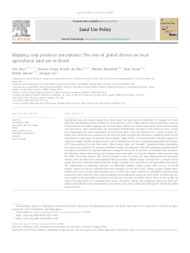Mapping crop producer perceptions: the role of global drivers on local agricultural land use in Brazil.
Mapping crop producer perceptions: the role of global drivers on local agricultural land use in Brazil.
Author(s): DOU, Y.; SILVA, R. F. B. da; BATISTELLA, M.; TORRES, S.; MORAN, E.; LIU, J.
Summary: ABSTRACT. Agricultural trade and climate change have altered land cover and land use worldwide. For example, the recent growth of international soybean demand has been associated with 1.3 Mha primary Amazon forest loss and up to 13-fold increase in double-cropping areas in Brazil. Many studies have tried to understand which and how global and local drivers affect deforestation and agricultural intensification processes at the landscape level, yet few have incorporated the direct perspectives of actual land users. Under the influence of a variety of social, economic, and cultural factors, producers are the ones who make decisions that will cause a significant impact on the environment. In this paper, we adopted Fuzzy Cognitive Maps (FCMs), a semi-quantitative modeling approach to represent complex decision-making systems, and we modeled land use and agricultural management perceptions of 27 crop producers from the three states - Mato Grosso, Goi´as, and Tocantins - important soybean production and export areas in Brazil. We analyzed individual models and integrated them into aggregated regional models to compare individual and regional differences among the producers. In addition, we simulated how producers from the three states will make land-use decisions under more trade and extreme climatic events scenarios using the FCMs. Our results indicate that extreme climatic events are among the most important factors producers consider when it comes to the sustainability of their operations. Climate change scenarios have a stronger overall impact than trade scenarios on local land-use changes, causing a 12% reduction in total agricultural production. The improvement of technology packages can effectively mitigate climate change risks and has an overall positive impact on land-use intensification than expansion. On the other hand, sharing accurate climate information and socio-economic improvements such as credits have larger impacts on agricultural expansion than productivity itself. Moreover, the model complexity shows differences among the three states. Soybean trade has more weight in the perception of producers in Goi´as and Tocantins than Mato Grosso. Based on the results, we discuss the importance of co-designing place-based, alternative policies and mitigation options for both agricultural intensification and environmental conservation, taken into consideration through the intertwined global and local forces.
Publication year: 2023
Types of publication: Journal article
Observation
Some of Embrapa's publications are published as ePub files. To read them, use or download one of the following free software options to your computer or mobile device. Android: Google Play Books; IOS: iBooks; Windows and Linux: Calibre.
Access other publications
Access the Agricultural Research Database (BDPA) to consult Embrapa's full library collection and records.
Visit Embrapa Bookstore to purchase books and other publications sold by Embrapa.

